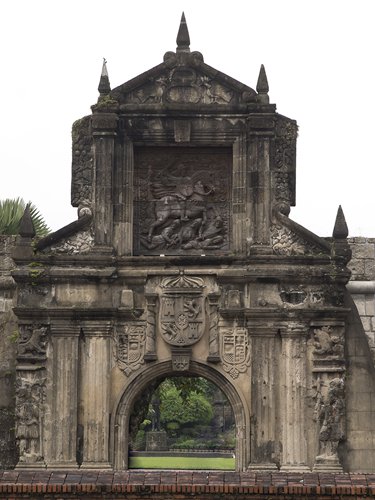HOME >> OPINION
China leaves its mark in Philippines
By Ding Gang Source:Global Times Published: 2019/7/31 22:08:42

Fort Santiago in historical district of Manila (Photo: IC)
Intramuros is the historic center and oldest district of Manila, the capital of the Philippines. Fort Santiago, an iconic building located in Intramuros, was built between 1589 and 1592. History has left four deep imprints on the fort, symbolizing the four most important periods in the history of the Philippine archipelago.The first imprint was left by Spanish colonists. They began their colonial rule from here. The second imprint was left by José Rizal, national hero and founding father of the Philippines, who was imprisoned at Fort Santiago for leading a rebellion against Spanish colonists. His lifework is exhibited at the Rizal Shrine, a museum inside the fort.
Fort Santiago is also a witness to the massacre of Japanese invaders during World War II. Thousands of Filipinos detained there were slaughtered by Japanese troops in 1945. The atrocity is a part of the Manila massacre, during which approximately 100,000 civilians were indiscriminately killed, according to incomplete statistics.
Americans left Fort Santiago with a fourth imprint. When US soldiers took over Manila from Japanese aggressors, they found over 400 bodies of Filipinos in the castle. The Battle of Manila is a turning point in the Pacific War. Till now, when Americans talk about the period, they quote what MacArthur said after he landed in the Philippines: "People of the Philippines, I have returned!"
While standing on the ramparts of the fortress and looking along the river, I saw a bridge under construction not far away. That's the Binondo-Intramuros bridge, a China-aided project. The bridge is yet to be officially named. But it is certain that China will leave its imprint on this core area of Manila. Two years later, when the new bridge opens, traffic between the old city and main business districts will become smoother.
Before the Spanish arrived in the Philippines, many Chinese had crossed the ocean and reached the archipelago. A famous example is the fleet of Zheng He, a Chinese explorer from the Ming Dynasty (1368-1644). But at that time, the Chinese didn't leave too many footprints. After the WWII, there came the Cold War, in which China's connection with most countries surrounding the South China Sea was cut off. As allies of the US, Southeast Asian countries like the Philippines became part of US strategy to lay siege to China.
The old days are gone. During the 40 years of China's reform and opening-up, China and ASEAN members have been getting closer. One reason is that China's rapid development has had a strong spillover effect. The other is that Southeast Asian countries have entered a new development cycle, which sees the increase in the demand for regional trade and economic exchanges as well as less dependence on outside forces.
This has made it possible for some heated regional issues to be resolved or eased through negotiations. And this is a key reason why China assists the Philippines.
The Estrella-Pantaleon Bridge is another project rebuilt by China Road and Bridge Corporation. The total amount of assistance for the two bridges, dubbed bridges of friendship, is 580 million yuan ($84.2 million). Besides, the project of China-aided drug rehab center has started its operations in April. All these projects aim at improving living standards in the country. Project director Virgilio C. Castillo, from the Department of Public Works and Highways, said the two bridges are the bridges of friendship.
China leads the world in bridge construction technology. Although the two bridges mentioned above are just a cakewalk for Chinese companies, they have adopted the most advanced disassembly technique to quickly and integrally move away the old bridge structure.
Not far from the Binondo-Intramuros Bridge there is an ancient building under renovation - a prison dated back to the Spanish colonial period destroyed by Japanese bombings in the WWII. The Chinese company is taking special care of the building while constructing the bridge. Technicians regularly examine the old building to make sure its outer walls are not affected by the construction.
Combined, all these elements - the prison built by Spanish colonists, bombings of Japanese force, and bridges of friendship constructed by Chinese - will tell a story. The two China-financed bridges are not very outstanding among the tens of thousands of bridges in the Philippines, but they will certainly leave an impression on the country's modern history of bridge construction.
This is just where Chinese footprints start.
The author is a senior editor with People's Daily, and a senior fellow with the Chongyang Institute for Financial Studies at Renmin University of China. dinggang@globaltimes.com.cn. Follow him on Twitter @dinggangchina
Posted in: ASIAN REVIEW